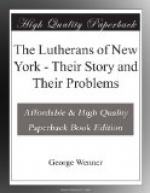When Lutherans of various churches and synods were thus brought together there was one thing that puzzled them. They could not understand why there should be so many kinds of Lutherans and why they should have so little to do with one another. This feeling soon found expression in the organization of societies of men interested in the larger mission of the Church.
In 1883 the Martin Luther Society was organized by such laymen as Arnold J. D. Wedemeyer, Jacob F. Miller, John H. Tietjen, Jacob A. Geissenhainer, George P. Ockerhausen, Charles A. Schieren, John H. Boschen and others, originally for the purpose of preparing a suitable celebration of the Luther Quadricentennial. In this effort they were successful. In addition to their local work in the interest of the celebration they secured the erection of a bronze statue of Luther in Washington.
But the chief reason for the organization of the Society was indicated in a letter sent to the pastors and church councils of the Lutheran churches of New York and vicinity which read in part as follows:
“In view of the efforts made all around us to bring about a closer and more harmonious relation between the various Protestant denominations, the Martin Luther Society of the City of New York respectfully begs you to consider whether the time has not come to make an effort to bring about, if not a union, at least a better understanding and more fraternal intercourse between the Lutherans themselves. We all deplore the divisions that separate us; we believe that the reasons for these divisions are more imaginary than real, and we are persuaded that a free and frank interchange of opinions will materially help to remove whatever obstacles may be in the way.
“We surely recognize the fact that our Lutheran Church does not command that influence or maintain that position in this city and vicinity which its history, purity of doctrine and conservative policy entitles it to; and we may be sure that just so long as our divisions continue, loss of membership and prestige, increasing weakness, and final disaster, will be our lot.
“Brethren, in unity is strength. Earnestly desiring to do what we can to bring it about, we ask the pastors of our Church and their church officers to take this important matter into consideration, and to take steps to participate in a meeting in this behalf which the Martin Luther Society proposes to hold on Tuesday evening, January 22d, 1889, in the hall of the Academy of Medicine, No. 12 West 31st Street, in this city.”
The annual banquet of the Martin Luther Society was an important function. Distinguished speakers lifted high the banner of Lutheranism, and good fellowship began to be cultivated among the representatives of churches and synods hitherto unacquainted with each other. Nearly all of its members have passed on and the Society is only a memory among a few survivors of those who shared its genial hospitality and recall the kindly fellowship of its meetings. The Martin Luther Society blazed the trail for the wider path on which we are walking today, and it deserves to be held in honored remembrance.




